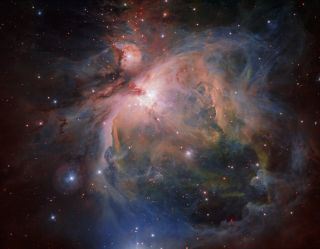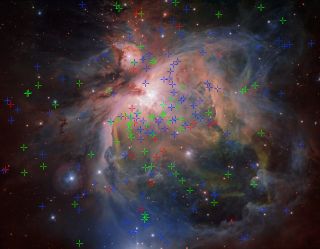Surprise! Orion Nebula Cluster Had 3 Ages of Star Formation
The Orion Nebula is one of the most heavily studied astronomical targets in the night sky, but that doesn't mean it has stopped surprising astronomers. In fact, new work suggests that its many young stars formed in three distinct waves, over just a few million years.
As the active star-forming region that's nearest to Earth, located around 1,350 light-years away in the constellation of Orion, the nebula is known to contain a bevy of young stars that occupy the Orion Nebula cluster. Now, astronomers using the OmegaCAM instrument on the VLT Survey Telescope (VST), located at the European Southern Observatory's (ESO) Paranal Observatory in Chile, have revealed previously unknown detail in this population of stars.
By precisely measuring the brightness and color of all the stars in the cluster, the researchers determined the ages and masses of the stars. The study, accepted for publication in the journal Astronomy & Astrophysics, describes a surprise discovery that there are in fact three different populations of young stars. [The Splendor of the Orion Nebula (Photos)]

This means that star-formation processes driven by the Orion Nebula happened over three distinct phases, rather than at the same time as was previously thought, the researchers said. And it all likely happened in just a few million years.
This finding could transform our understanding of the age distribution of other star clusters, the study's researchers said in a statement, and it adds new detail to the story of star-formation processes.
"Looking at the data for the first time was one of those 'Wow!' moments that happen only once or twice in an astronomer's lifetime," Giacomo Beccari, an ESO astronomer and the lead author of the study, said in a statement. "The incredible quality of the OmegaCAM images revealed without any doubt that we were seeing three distinct populations of stars in the central parts of Orion."

The researchers also investigated another possible explanation for the variety of star colors and brightnesses, however: If some of the stars have closely orbiting stellar partners that are unresolved in the OmegaCAM observations, they may appear redder and brighter, masking their true age.
Get the Space.com Newsletter
Breaking space news, the latest updates on rocket launches, skywatching events and more!
Through analysis of other observations of the stars' spin and spectra, however, the researchers deduced that the brightness and color data is likely not being skewed by hidden stellar companions. If they did have binary partners, that would imply the stars had very unusual properties, according to the statement.
"Although we cannot yet formally disprove the possibility that these stars are binaries, it seems much more natural to accept that what we see are three generations of stars that formed in succession, within less than 3 million years," added Beccari.
"This is an important result," said Monika Petr-Gotzens, study co-author and ESO astronomer. "What we are witnessing is that the stars of a cluster at the beginning of their lives didn't form altogether simultaneously. This may mean that our understanding of how stars form in clusters needs to be modified."
The upshot: The famous star-forming region created stars in bursts, and the period of star birth happened much faster than scientists previously thought, the researchers said.
Follow Ian O'Neill @astroengine. Follow us @Spacedotcom, Facebook or Google+. Originally published on Space.com.
Join our Space Forums to keep talking space on the latest missions, night sky and more! And if you have a news tip, correction or comment, let us know at: community@space.com.
Ian O'Neill is a media relations specialist at NASA's Jet Propulsion Laboratory (JPL) in Southern California. Prior to joining JPL, he served as editor for the Astronomical Society of the Pacific‘s Mercury magazine and Mercury Online and contributed articles to a number of other publications, including Space.com, Space.com, Live Science, HISTORY.com, Scientific American. Ian holds a Ph.D in solar physics and a master's degree in planetary and space physics.
